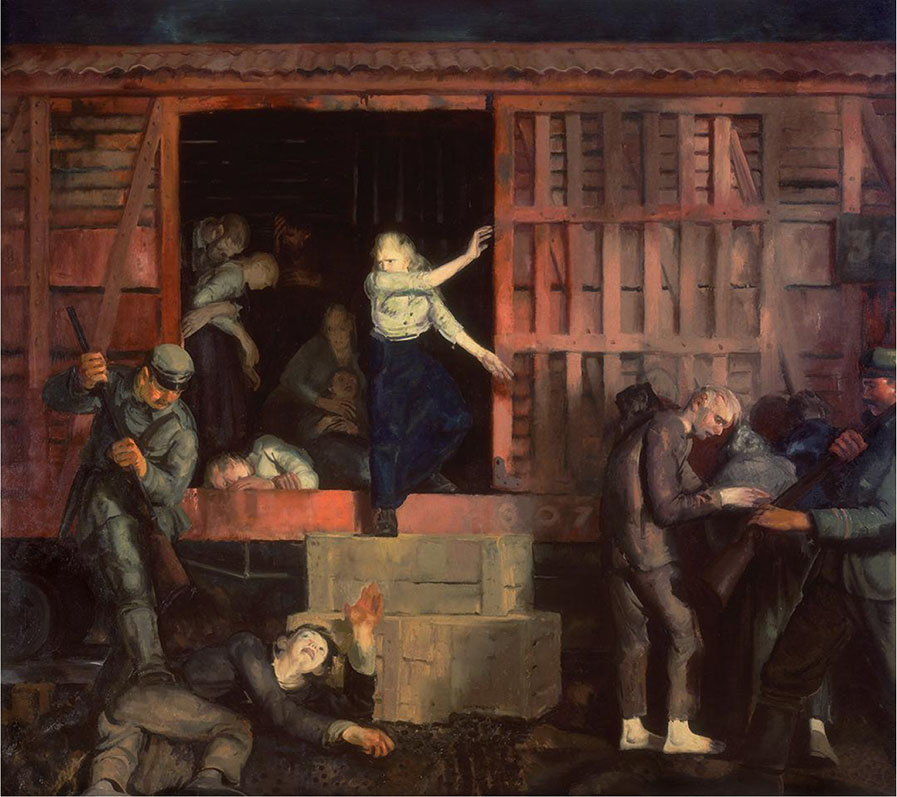Module 7: Americans in the Great War, 1914-1919
Section outline
-
 Image from Chapter 23 of U.S. History (opens in new window) from OpenStax, licensed under Creative Commons Attribution License v4.0 with the image information: Return of the Useless (1918), by George Bellows, is an example of a kind of artistic imagery used to galvanize reluctant Americans into joining World War I. The scene shows German soldiers unloading and mistreating imprisoned civilians after their return home to Belgium from German forced-labor camps.
Image from Chapter 23 of U.S. History (opens in new window) from OpenStax, licensed under Creative Commons Attribution License v4.0 with the image information: Return of the Useless (1918), by George Bellows, is an example of a kind of artistic imagery used to galvanize reluctant Americans into joining World War I. The scene shows German soldiers unloading and mistreating imprisoned civilians after their return home to Belgium from German forced-labor camps.This module explores America during World War I. You will examine how President Woodrow Wilson initially attempted to keep America out of the conflict between the European powers, and the events--including the sinking of U.S. ships by German u-boats and the infamous Zimmerman telegram--that shifted American opinion in favor of war. You will explore the government's efforts to prepare for war, including increased control over the economy, a propaganda campaign, and a military draft. You will also analyze the government's repressive measures, including the use of new laws to silence opposition to the war. You will investigate the changing American home front, including new opportunities for African Americans and women, particularly for the latter group with the passage of women's suffrage. You will examine the American contributions to the Allies' success, and the failure of President Wilson's Fourteen Points. Finally, you will analyze the difficult post-war period marked by the Influenza Pandemic of 1918-1919 and anti-Black riots.
Upon completion of this module, you will be able to:
- Explain Woodrow Wilson’s foreign policy and the difficulties of maintaining American neutrality at the outset of World War I (CO 1-7)
- Identify the key factors that led to the U.S. declaration of war on Germany in April 1917 (CO 1-5)
- Identify the steps taken by the U.S. government to secure enough men, money, food, and supplies to prosecute World War I (CO 1-5)
- Explain how the U.S. government attempted to sway popular opinion in favor of the war effort (CO 1-7)
- Explain how the status of organized labor changed during the First World War (CO 1-5)
- Describe how the lives of women and African Americans changed as a result of American participation in World War I (CO 1-5)
- Explain how America’s participation in World War I allowed for the passage of prohibition and women’s suffrage (CO 1-7)
- Identify the role that the United States played at the end of World War I (CO 1-5)
- Describe Woodrow Wilson’s vision for the postwar world (CO 1-7)
- Explain why the United States never formally approved the Treaty of Versailles nor joined the League of Nations (CO 1-5)
- Identify the challenges that the United States faced following the conclusion of World War I (CO 1-5)
- Explain Warren G. Harding’s landslide victory in the 1920 presidential election (CO 1-5)
To achieve these objectives:
- Read the Module 7 Introduction above.
- Read and view the materials in Module 7 (click below)
- View the Module 7 PowerPoint below.
- Complete Module 7 quizzes/assignments/discussion boards based on chapter/document reading.
Background Colour
Font Face
Font Kerning
Font Size
Image Visibility
Letter Spacing
Line Height
Link Highlight
Text Colour
